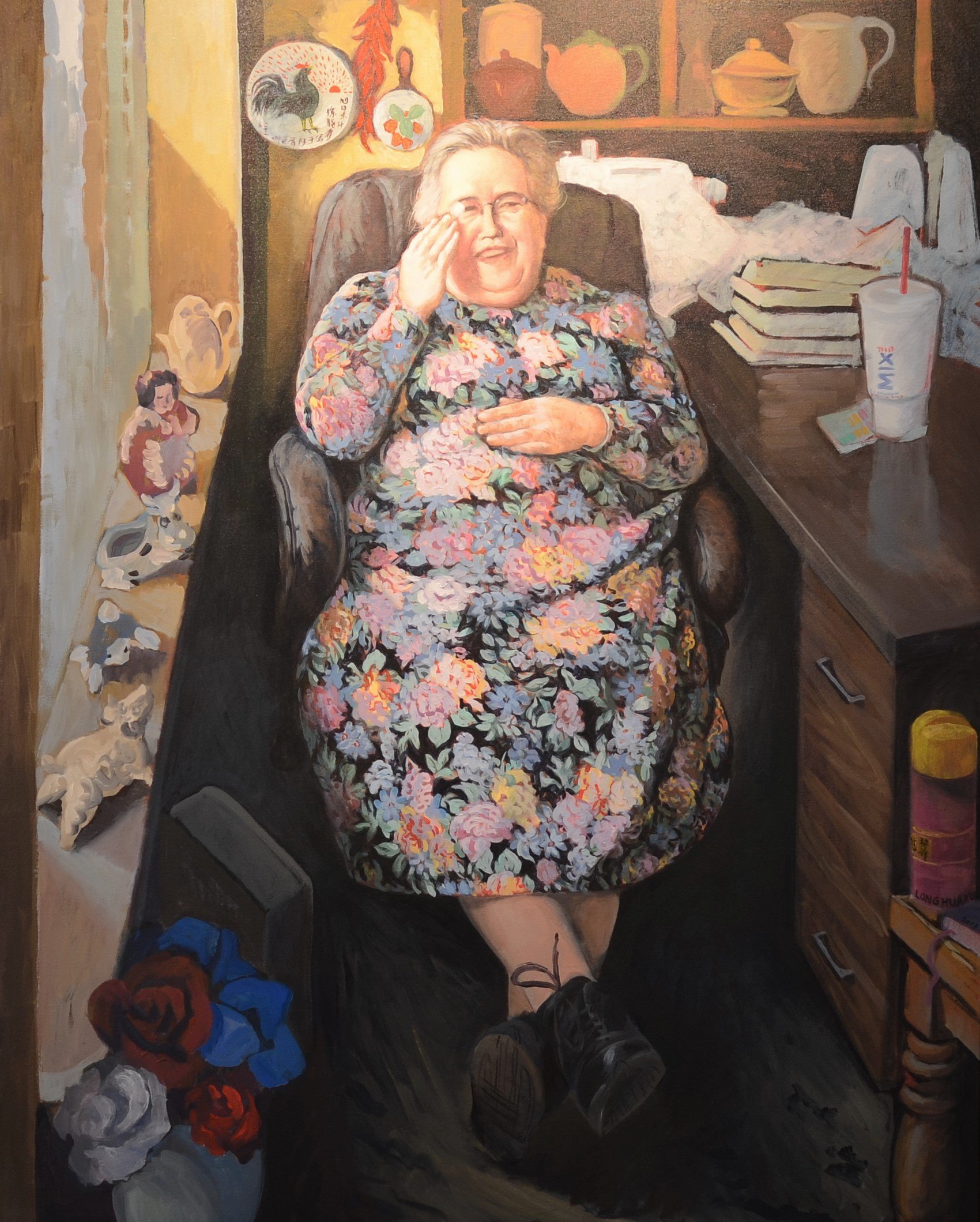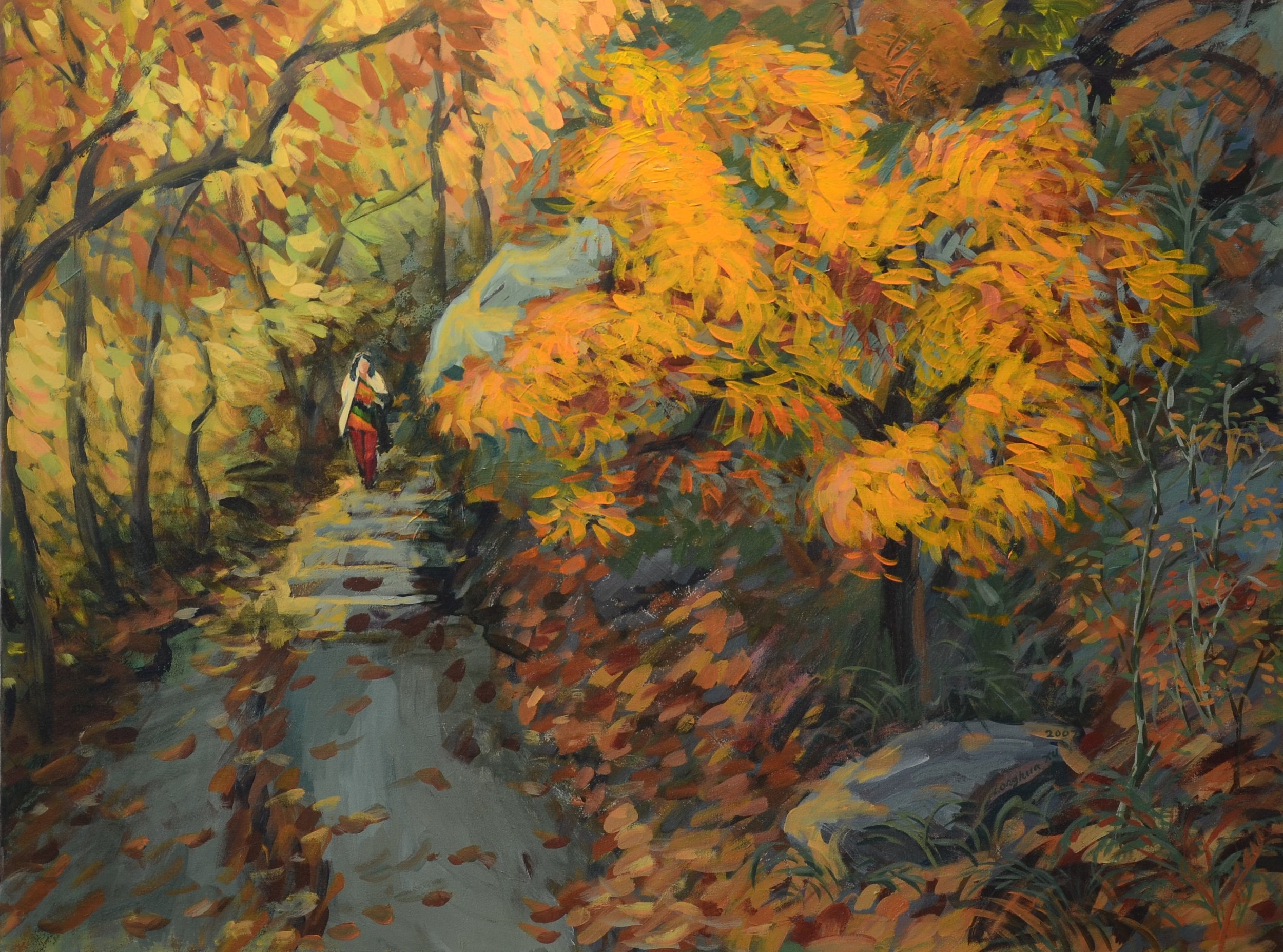Interview with artist Longhua Xu
In 2019, Longhua Xu received the Arkansas Living Treasure award from the Arkansas Arts Council. He left Shanghai, China in 1989 and eventually made Hot Springs, Arkansas his home and ‘studio’. Longhau’s spectacular sculptures dot the city and complement the beauty of Hot Springs and its people, which he says inspires him. His sculptures, carvings and paintings are always uplifting and demonstrate his immense talent. More of Longhau’s work can be found at his website xu-longhua.com.
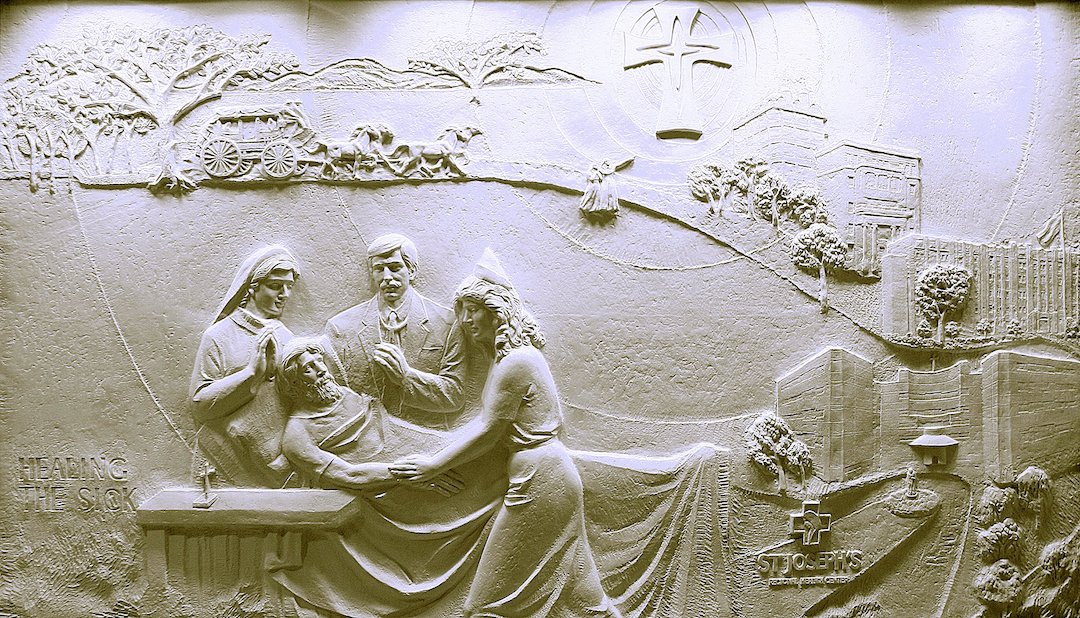
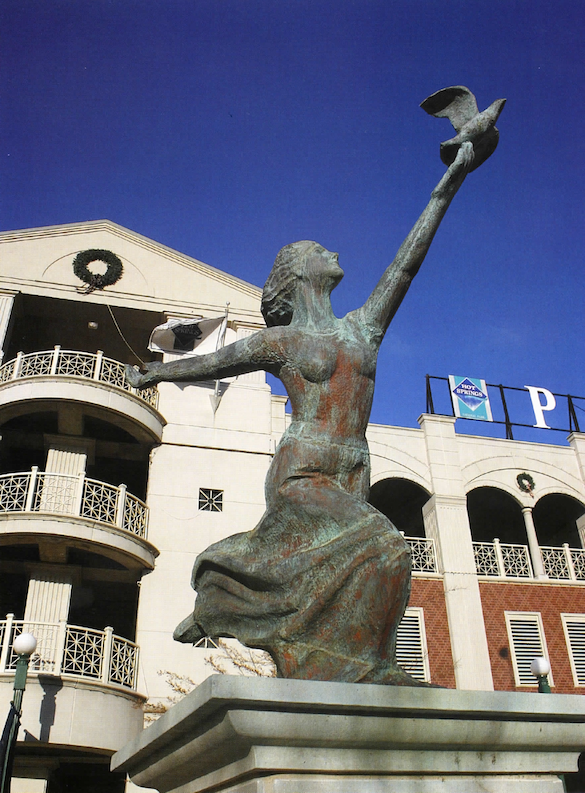
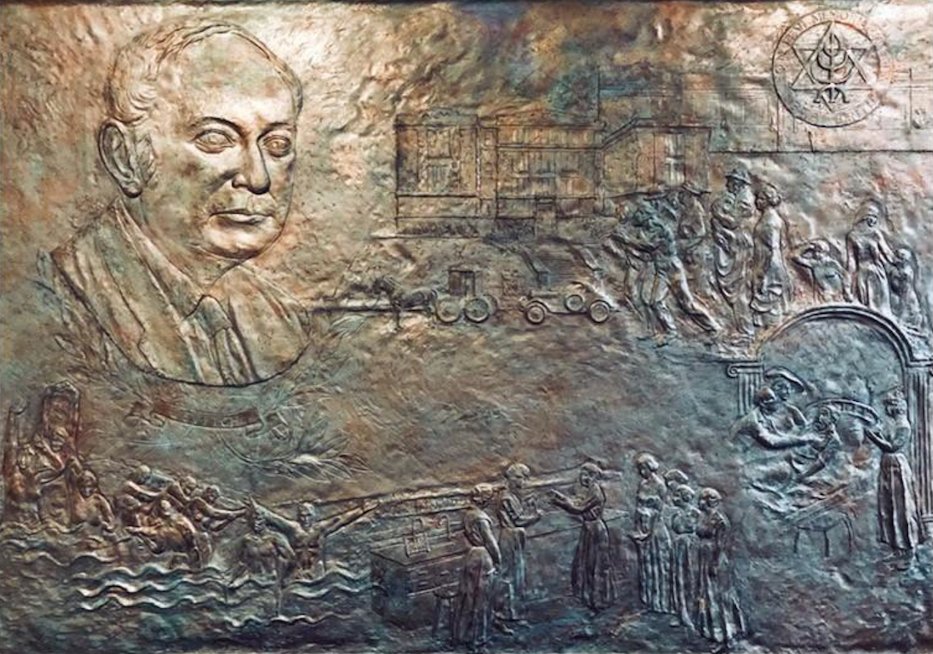
AAS: Longhua, first of all, congratulations on being named the 2019 Arkansas Living Treasure by the Arkansas Arts Council! What a great honor.
LX: First I would like to thank JoAnne Mangione, of Hot Springs, for this award nomination, and the State of Arkansas for selecting my work as worthy of this recognition. The Arkansas Democrat-Gazette, also did a phenomenal job covering my work highlighted by this competition. This honor of course serves as validation for my early works and my journey as an artist, as well as motivation to strive for even better creations in the future. Much like how pressure is required to produce beautiful diamonds, it also serves as a critical catalyst to the creative process.
AAS: You have been in Hot Springs for 30 years. What made you decide to move there from China?
LX: I initially came to America as an exchange professor. All my prior knowledge about the United States had come from movies and popular culture exclusively. Being born and raised in Shanghai, the largest, most modern city in China, it was initially shocking to find that America was not always the modern, glamorous big cities that is portrayed by Hollywood. Instead, I discovered a beautiful, wooded countryside that was an idyllic place to raise our two young children.
Grandma’s Baby, 60” x 48”, acrylic on canvas
Both my son and daughter have now gone on to become physicians, but also retain the artistic talents taught by my wife and me. They caught on early that it is not so easy to survive as an artist in America. Regarding raising such a wonderful family and supporting my art career, I have none more to thank than my beloved wife. She gave up her successful academic career at Shanghai University to become a homemaker and helped manage my artistic career here. Without her, we could not have survived as a family in the United States.
AAS: Talk about your educational background and the teaching you have done in China and here in Arkansas.
LX: The cultural differences between China and America are quite vast. The thought process used here for problem solving and attitudes toward certain subjects are very different. For example, in America we commonly see families emphasize the athletic aspects of grade school through extracurricular activities, like football or basketball, during the same informative years that Chinese families instead opt to take the children to music lessons and art classes. Because of this difference in background, most Chinese students I taught as a university professor, focused not on fundamentals, but on abstraction and composition. They had already learned the basics of technique as children. Also, instead of taking art as an elective course, all the students I taught in China had already chosen art as their future profession. One way of teaching isn’t necessarily better than the other, however, the demands on the professor are quite dissimilar.
Both types of students are entirely different from my upbringing. My wife and I were both selected from all of Shanghai, a population of 14 million people, to be two of only 50 students to be trained as professional artists. We grew up during the Cultural Revolution, so all universities were closed at that time. Education was completed for most to a high school level. After which, if you were not talented enough to be selected for further training, you were sent to work on large community farms to support the country.
“My greatest lesson in life, came from the hands of masters who taught me at their side, the importance of studying the old masters who came before us.”
AAS: The breadth of your work is remarkable – wood, stone, bronze, paint. I hope we can cover some examples of each. Let’s begin with Mother Nature, that extraordinary marble sculpture in downtown Hot Springs. That was completed soon after you moved there. What were the circumstances around that piece? Why did you create it and incorporate those elements?
Mother Nature (detail), cultured marble
LX: When moving to America most people thought my art was limited to painting exclusively. To create monumental sculptures, you need both the funding and the space to work – neither of which I was fortunate enough to have at the time. After moving my family here, I was able to truly create art as a sculptor. To create a piece, you must capture the essence of your surroundings. For Mother Nature, I felt Hot Springs needed an icon to truly represent this city I now call home. Its healing waters reminded me of the role of a mother, always nurturing her children, the citizens of Hot Springs, which are surrounded by the natural beauty of the area represented by the hares and deer. My goal is to personify the beauty of this place so that everyone can feel the wonder that this place inspires in me. The fluidity of the movement both of each individual animal as well as how the entire composition is arranged were inspired by the movement of water. Many people still criticize the deer antlers, saying they are arranged backwards. Those people fail to recognize that art serves not to imitate but to narrate life. It is not meant to be only a replica of life itself.
Thank you for thinking Mother Nature is made from marble, however, it was cast from fiberglass to imitate marble. The city budget was only enough to cover the materials required to make a fiberglass casting of my original clay piece. My own time and efforts were all donated due to budgetary constraints. My passion about this piece was such that I believed it had to be born into fruition. I deeply appreciate the recognition this sculpture has garnered. It is an honor to receive a personal letter from President William Jefferson Clinton, praising my efforts as an outstanding artist in America, and to be recognized in the Smithsonian Institutes Guide of Outstanding Outdoor Works of Art in America.
Mother Nature, 22’ x 12’ x 8’, cultured marble, downtown Hot Springs, Arkansas
AAS: Another incredible work is Celebration of Life at CHI St. Vincent hospital. Would you talk about that bronze sculpture?
LX: Celebration of Life was a combined vision between former CEO Randall Fale of then St. Joseph’s Hospital and me. He is a scrutinizing individual with discerning artistic taste, although he never mandated what I created. Instead, he told me the location and a rough idea of what was required and left the creative process entirely to me. However, this sculpture took me ten tries to get it right. He does not readily give consent to a work he deems insufficient, and I do not readily give up on my own artistic visions, so it was a constant volley of ideas between the two of us to create this current work. I was honored to tour the facility many times, speaking with patients and staff before creating this current iteration. These conversations culminated, in my understanding, that the most frightening part of cancer for patients and providers was not the treatments or diagnosis itself, but rather the unknown response a patient would have to their treatment and how long they would survive. My work needed to help ease their fears and inspire these fighters to continue their battle against cancer. That is why I created three angels to face each of the three entrances to the hospital. Each angel is cascading flowers and welcoming these weary souls to continue their fight towards freedom. It was one of my proudest moments that patients and their families would frequently stop me on the street after the dedication ceremony to thank me for my work. They affirmed that my sculpture had indeed given them hope after they had completed another radiation treatment or a round of chemotherapy. It is moments like these that are truly rewarding for an artist – to know that your audience has fully understood your intention.
Celebration of Life, 12’ x 12’ x 12’, bronze, Cancer Center-CHI ST. Vincent, Hot Springs, Arkansas
AAS: Another bronze piece is Reach for the Stars at the Main Street Visual and Performing Arts Magnet School [formally the Oaklawn School]. What is the story behind that piece?
Reach for the Stars, 5.5’ x 5.5’ x 3’, bronze, Main Street Visual and Performing Arts Magnet School, Hot Springs, Arkansas
LX: The original inspiration for Reaching for the Stars was to serve as an inspiration for the youth of this dance and art magnet school. It is designed as a literal personification for children to reach for their dreams. However, due to cost constraints by the school, we were initially unsure if we would be able to complete this piece. My wife [Shunying Chen], John and Delores Jenkins, Mary Moore, Suzanne Tucker, Dorothy Morris, Donald Munro, Linda Koehn, Janice McCoy, Debbie Kopf, and the Hot Springs School District were donors for this sculpture to come to fruition. This was another project where my time to complete the project was donated. As a teacher and fellow creative spirit, I felt it was vital that we continue to inspire the pursuits of the next generation.
AAS: I would like to now talk about some of your wonderful paintings, particularly your portraiture work. Sisters and Piano Prodigy just blew me away.
LX: As a young child, since we weren’t allowed to take art, I would go out into the countryside and sketch with my older brother. Professionally, I began to focus on becoming a sculptor at the age of 17. My hero since childhood has been Michelangelo, and like him, I believe that to become a master sculptor you must also understand the various other forms of art such as painting and carving. They are all related, and knowledge of each field helps to further your understanding and mastery of the other. My greatest lesson in life, came from the hands of masters who taught me at their side, the importance of studying the old masters who came before us. As a young man in training, books were our only source at a time before the internet, I would never leave the library voluntarily and was frequently kicked out every night at closing time at 11pm.
Sisters, 48” x 36”, oil on canvas
Piano Prodigy, 42” x 32”, acrylic on canvas
AAS: You have done some terrific paintings with a Matisse feel to them – the flowing lines and movement. I especially like A Corner of the Gallery with your artwork hanging behind the woman. Would you talk about those and artists who you admire?
A Corner of the Gallery, 20” x 24”, acrylic on canvas
LX: A Corner of the Gallery shows the gallery opened by my students. The abstract painting in the background is added by me for the purpose of the picture. It’s interesting that you bring up Matisse. Like my own work, his works were influenced by other cultures. After he studied several Asian (as well as Arab and African) works of art, his art was inspired by those cultures. My Chinese aesthetic, when combined with formal western training, interestingly yielded similar results in a convergent evolution of ideas if you will. Our shared interest of sculpture affects our views on painting in similar ways. He is definitely an artist I admire. Some other greats that I’ve held in high esteem are Rodin, Degas, and da Vinci.

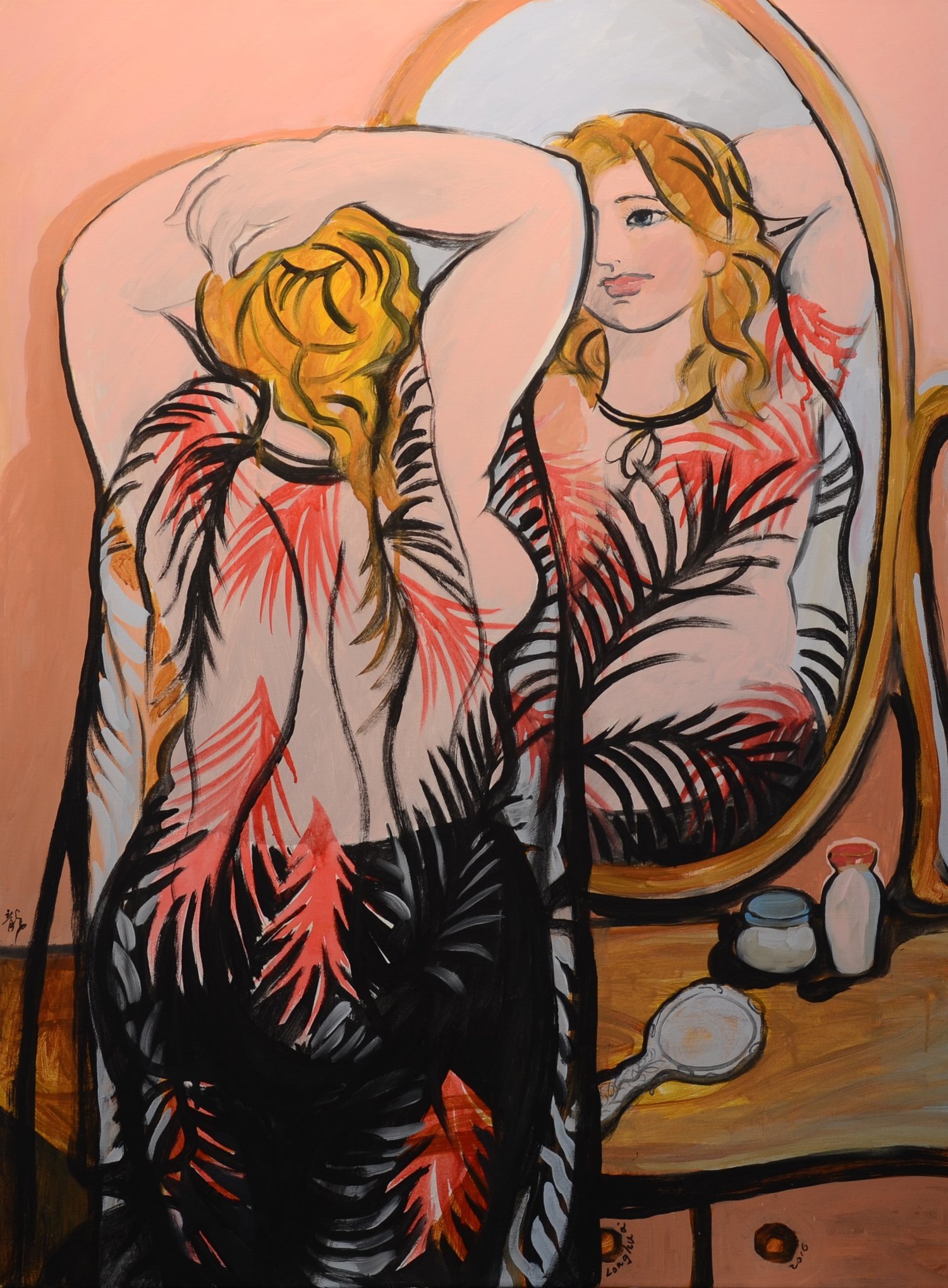
AAS: You have also done some smaller sculptures in stone and wood. Two I really like are Rhythm and Mountain. Which do you like best – working on large sculptures or smaller ones?
LX: When my wife and I had spare time, we frequently visited rock stores and the outdoors to look for many raw stones. We enjoy collecting these stones because each stone, in its natural environment, is a literal culmination of time and minerals over thousands of years creating a natural beauty. After collecting these stones for some time, my inspiration is much like the great Michelangelo is quoted as saying, "Every block of stone has a statue inside it, and it is the task of the sculptor to discover it.” My start in art in China was actually as a wood carver, like stone, there is already a form existing within each piece of wood that is beautiful. It simply requires a bit of help to be freed from the rest of the structure that has grown around it.
The difference between small and large sculptures is predominantly ease of creation. Small sculptures can be created on a whim and then the location for the piece can be decided later because they are so easy to store. Large sculptures require far more forethought. You must consider the environment and how it will interact with the medium of the sculpture, what natural beauty exists in the area so that the sculpture will match the setting, and who is the audience that you are trying to reach with your work. Without considering all these factors prior to making a piece, you will fail to captivate the imagination of the public and will have created a mismatched work.

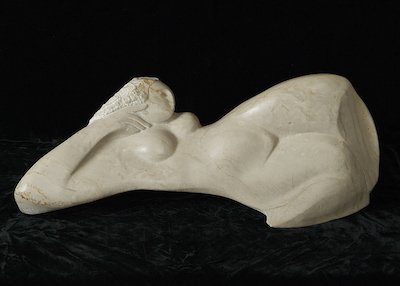
AAS: You have done some terrific commissions like Angus. Are commissions for private residences something you enjoy doing?
Angus, 7’ x 7’ x 7’, bronze, private collector, Greenwood, Arkansas
LX: Speaking of Angus reminds of the story regarding the circumstances at the time of its commission. The private owner hired me initially only to make Angus a gate for his property. When asking him, “What is the budget for your property and for this work?” He promptly responded he was spending several million dollars to develop his farm, but he had only allotted three thousand dollars for the creation of this gate. This made me laugh, and my client chuckled too, but asked why we were laughing. I said: “Would you ever buy an expensive tuxedo but wear a two-dollar tie?” He understood my meaning immediately and responded, “I have no experience in this area. What do you suggest?” It was through the process of this conversation that we ended up designing the entrance gates to the property, the sculpture of the lady next to the swimming pool, and the courtyard that would house Angus.
Venus, cultured marble, private collector Greenwood, Arkansas
It is important to always understand the context that inspires my clients, “Why angus bulls?” They are artistically speaking not the most exciting bull you could depict, as they have no horns, that we typically imagine. As a child, the client grew up helping raise a wealthy man’s bulls, which was different from his family’s standing. He struggled all his life through hard work and eventually made his fortune in a self-made business. He was then able to raise his own angus bulls since they are desired for their excellent quality meat and are a practical animal to raise. Understanding his story helped me depict his struggle in the relief at the base of the sculpture Angus with the final bronze piece standing victoriously in the center. Since angus bulls have no horns, artistically I used the ears as substitutes for horns, in order to present its strength and power.
Every commission is a conversation between the artist, who supplies the expertise; and the client, who supplies the underlying vision. A successful commission is the synchronicity and mutual understanding between the two.
AAS: So, what is next for you, Longhua? What are you working on now?
The Visitor, work in progress
LX: The current public piece in the works is named “The Visitor.” In 2016, my wife and I wanted to develop a sculpture for Hot Springs as a way of our saying thanks to this place that has welcomed us with open arms and southern hospitality. Initially, the sculpture was named “The Explorer,” depicting the Spanish explorers that arrived 500 years ago. After discussion with many people, we were made aware of the deeper and longer history of visitors and explorers to the area by the Native American tribes. Hot Springs had been a ‘place of peace’ and enjoyment for those tribes seeking healing from the local waters for thousands of years. Legend tells stories of them putting down their weapons to take advantage of all that Hot Springs has to offer with its natural resources in the healing clays, thermal waters and novaculite. We really gravitated to that idea and decided to rename and change the theme. There has been an outpouring of support from small and large businesses in Arkansas and patrons. We anticipate the completion of this project by the end of next year.
AAS: Longhua, it has been an honor to learn more about you and your marvelous work - thank you.

